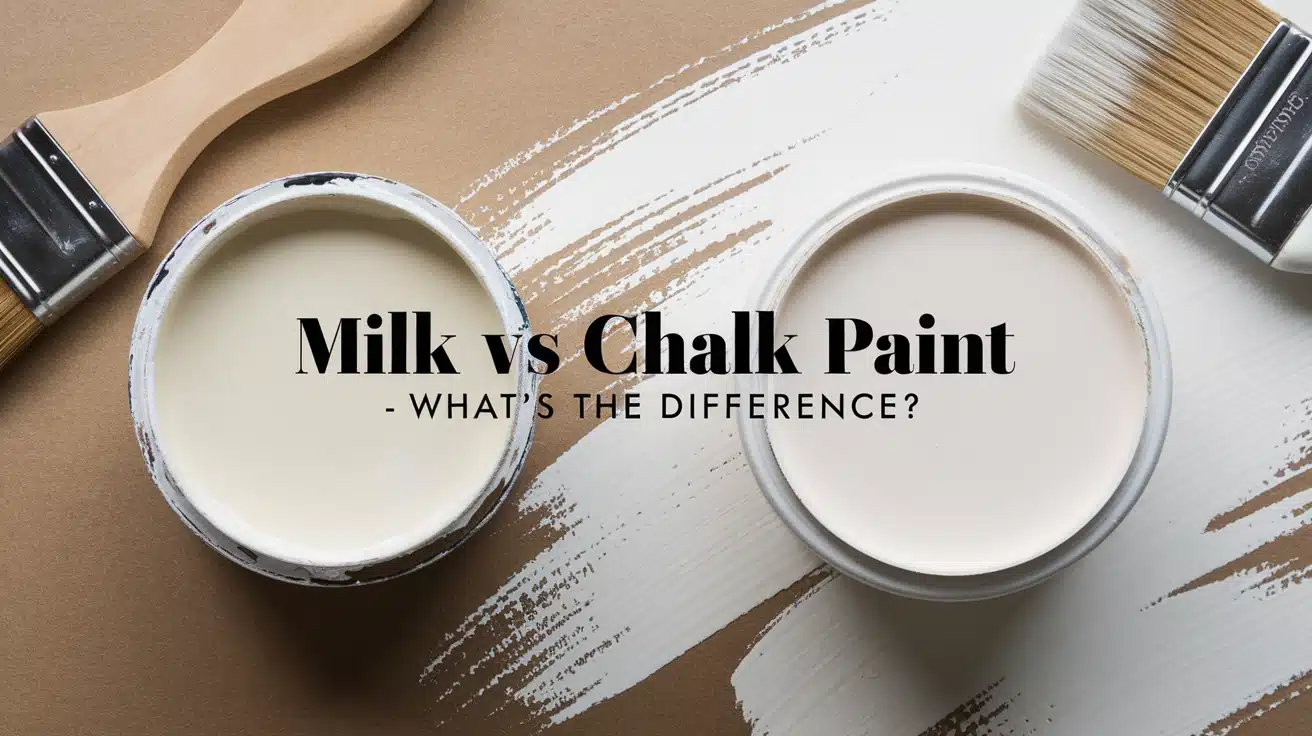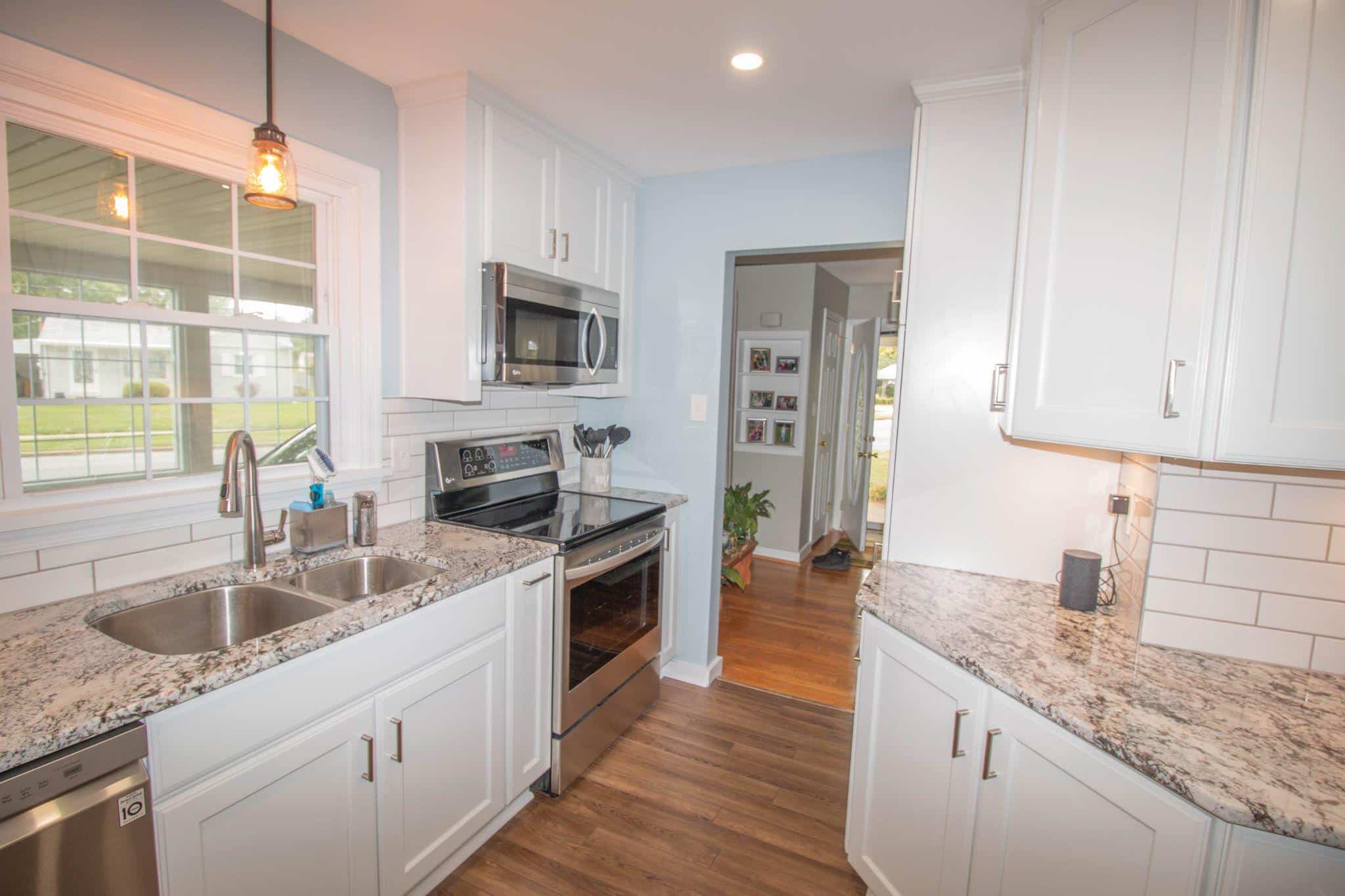Want to give your old furniture a fresh look? You’re not alone.
Many DIY enthusiasts find themselves choosing between milk paint and chalk paint for their projects.
While both create beautiful matte finishes, picking the right one can make a big difference in your results.
What if you could learn exactly how these paints differ and which one suits your specific project?
Our complete guide breaks down the key qualities of both paints, backed by real testing on multiple furniture pieces.
By the end of this guide, you’ll know precisely which paint will work best for your furniture makeover.
Ready to start your project?
Let’s examine these paints in detail.
Understanding Milk Paint
What Makes Milk Paint Special?
Milk paint brings a rich history to your furniture projects.
Dating back hundreds of years in French furniture traditions, this paint type stands out for its natural composition.
Traditional milk paint combines milk protein, lime, and color pigments mixed into a powder that requires water activation.
Today’s options include convenient pre-mixed versions, like Rust-oleum Milk Paint, which offers the same benefits without the mixing process.
The paint creates a distinctive velvety, matte appearance that many furniture enthusiasts prefer. Its non-toxic formula makes it a safe choice for indoor projects.
Best Uses For Milk Paint
This paint type excels in furniture updates, particularly when you want:
- A rich, deep color that adds character
- Minimal preparation work before painting
- A paint that covers surface imperfections well
- Small to medium-sized project flexibility
You can start painting most surfaces right away.
However, for glossy surfaces, a quick light sanding helps with adhesion.
The paint works particularly well on:
- Dressers and cabinets
- Wooden furniture pieces
- Musical instruments
- IKEA furniture updates
Important Note: While manufacturers might suggest otherwise, adding a protective finish helps prevent easy scratching and extends the life of your painted piece.
Understanding Chalk Paint
What Sets Chalk Paint Apart
Chalk paint has become a popular choice for furniture projects over recent years and for good reasons.
This paint type gives your pieces a smooth, matte finish that many find appealing.
Its standout quality lies in its simple application process – you can often start painting without extensive preparation work.
The paint offers good coverage and typically needs just one coat to achieve the desired look.
Its thick consistency helps it stick well to most surfaces, making it a reliable choice for various furniture types.
The finish has a softer appearance compared to milk paint, which some prefer for certain styles.
Common Uses for Chalk Paint
This paint works well for:
- Quick furniture updates
- Projects needing fast completion
- Pieces where you want consistent coverage
- Items that will receive regular use
The paint performs especially well on:
- Wood furniture
- Metal surfaces
- Previously painted items
- Laminate pieces
- Small decor items
While chalk paint can look somewhat dull, adding a wax coating helps protect the finish and gives it a subtle sheen.
The paint wears naturally over time, creating a lived-in look that many find appealing.
A key benefit of chalk paint is its forgiving nature – if you make mistakes during application, they’re usually easy to fix.
Its quick-drying properties let you complete projects faster than other paint types.
Milk Paint vs Chalk Paint: Side-By-Side Comparison
Similarities Between Both Paints
When comparing milk paint and chalk paint, several shared features make both excellent choices for furniture updates:
1. No Heavy Prep Work: Both paints stick well to most surfaces without extensive sanding. A quick clean of the surface is often enough to begin.
2. Simple Application: These paints spread easily with basic brushes or rollers. Their thickness makes them manageable for beginners and experienced painters alike.
3. Coverage Quality: Both types effectively hide small surface flaws and blemishes. They’re forgiving on imperfect surfaces.
4. Matte Results: Each painting creates a flat, non-shiny finish that suits many furniture styles.
Notable Differences
The key distinctions between these paints can help you make the right choice for your project:
| Category | Milk Paint | Chalk Paint |
|---|---|---|
| Protection Requirements | It needs a protective coat to prevent scratches | Benefits from wax coating but wears more naturally without it |
| Color Characteristics | Provides deeper, richer color with a velvety look | Creates softer, more uniform color coverage |
| Application Needs | Often requires 2-4 coats for full coverage | Usually needs only 1-2 coats |
| Durability Factors | Can scratch more easily without protection | Shows natural wear patterns over time |
| Cost Comparison | May need more coats, increasing overall project cost | Often more economical due to fewer coats needed |
| Finish Details | Can show some unevenness in color intensity | Typically provides more consistent coverage |
These differences might seem subtle, but they can significantly impact your project’s final look and longevity.
Understanding them helps ensure you select the right paint for your specific needs.
Making Your Choice
1. When To Choose Milk Paint
Select milk paint for your project when:
- You want a rich, deep color finish that adds character
- Time isn’t your main concern, as you’ll need multiple coats
- You plan to add a protective finish
- Your project would benefit from a velvety look
- You’re working on raw wood furniture
- You want a finish that looks like it has aged over time
Best project matches:
1. Antique furniture pieces
2. Raw wood items
3. Statement pieces that need depth
4. Small cabinets and dressers
5. Pianos and other musical instruments
2. When To Choose Chalk Paint
Choose chalk paint when:
- You need to complete the project quickly
- You want consistent color coverage
- You prefer a soft, uniform look
- Your budget is more limited
- You’re new to furniture painting
- You want fewer coats
Best project matches:
1. Quick furniture updates
2. Everyday use items
3. Beginner-level projects
4. Previously painted furniture
5. Pieces that need fast completion
6. Items where you want reliable coverage
3. Key Consideration Tips
1. Time Investment: Review your schedule and project timeline.
Milk paint requires 2-4 coats with drying time, extending the process to about 2-3 days.
Chalk paint needs only 1-2 coats and can be completed in a day, though additional time is necessary for protective coats.
2. Skill Level Assessment: For beginners in furniture painting, chalk paint allows for easier application and hides small mistakes.
Milk paint needs more skill for even coverage and may vary in color intensity.
Start with small pieces to gain confidence with either type.
3. Budget Planning: Milk paint might cost similarly per can, but you’ll need more for multiple coats.
Include protective finishes in your budget.
Chalk paint is often more economical as you’ll use less and may need fewer coatings.
4. Intended Usage: Use chalk paint with a protective finish for high-traffic items like coffee tables or dining chairs.
Milk paint suits display pieces or items with less daily use if sealed properly.
Remember that both paints offer quality results – your choice depends more on your specific needs and project goals than one paint is better.
Tips For Success
1. Application Best Practice
Before starting your paint project, prepare the surface by washing it with mild soap and water to remove dirt and oils.
For glossy surfaces, use fine-grit sandpaper to roughen the texture for better adhesion, then clean off the dust and let it dry, usually within 1-2 hours.
Check for and repair any loose or damaged parts for older furniture first.
2. Maintenance Tips
1. Daily Cleaning: Keep painted furniture fresh with soft, damp cloths for cleaning.
Avoid commercial cleaners that may damage the finish.
For stubborn marks, use mild soap mixed with water, avoiding saturation of the surface.
2. Scratch Prevention: Use felt pads under items on painted surfaces.
Employ tablecloths or placemats for dining.
Always lift, don’t drag items across painted surfaces.
Consider glass tops for frequently used tables.
3. Quick Fixes: Scratches may appear with use. Keep leftover paint for touch-ups.
Clean the area first, then apply paint with a brush.
Let it dry before adding a protective coating.
For deeper scratches, lightly sand before touching up.
4. Regular Inspection: Check your painted pieces monthly for signs of wear.
Look for scratches, chips, or areas where the protective coating seems thin.
Schedule regular maintenance, like reapplying protective coatings every 12-18 months, depending on use.
Keep records of when you last applied protection to help maintain a regular care schedule.
Final Thoughts
Choosing between milk paint and chalk paint depends on your needs and project goals.
Through this guide, we’ve explored how each paint type offers unique benefits for furniture updates.
Milk paint gives you a rich, velvety finish with more depth, though it needs multiple coats and proper protection.
Chalk paint offers quicker results with consistent coverage and easier application, making it perfect for beginners or time-sensitive projects.
Consider your time, budget, and desired outcome when selecting your paint.
Proper preparation and protection will ensure your painted pieces last longer, regardless of which paint you choose.
For best results, follow the application tips shared above, and don’t skip the protective finish step.
Your furniture will thank you with years of beautiful service.












